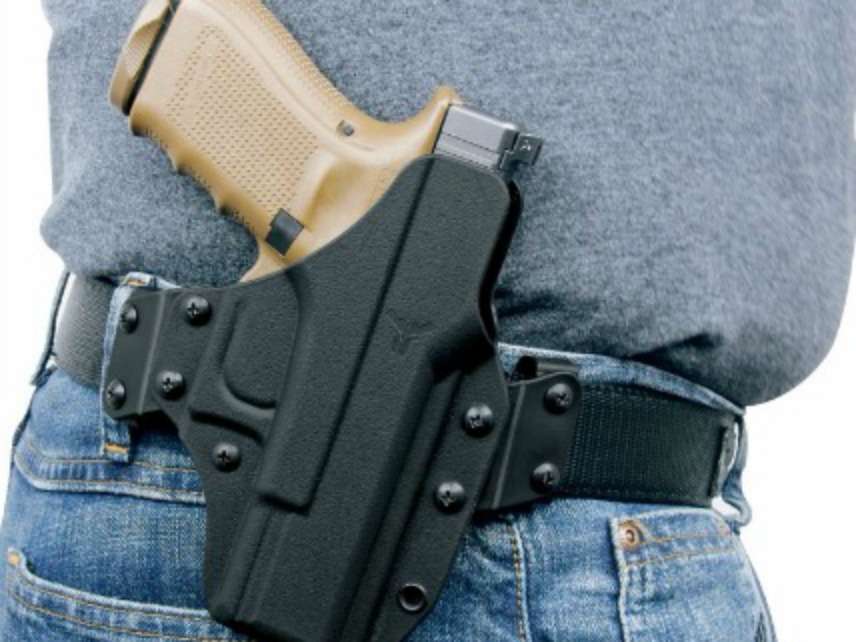Ban on Guns Near Parks Violates the Second Amendment, Illinois Supreme Court Says
The state's 1,000-foot rule made accidental felons out of people carrying firearms for self-defense.

Yesterday the Illinois Supreme Court unanimously ruled that a state ban on carrying guns within 1,000 feet of a public park violates the constitutional right to bear arms. The decision in People v. Chairez extends the logic of prior rulings by the same court and by the U.S. Court of Appeals for the 7th Circuit holding that Second Amendment rights exist outside the home and cannot be categorically restricted without a strong justification.
In 2013 Julio Chairez committed a Class 3 felony, punishable by two to five years in prison, when he carried a gun in the general vicinity of Virgil Gilman Trail, a park in Aurora, a Chicago suburb. Chairez pleaded guilty but subsequently challenged the constitutionality of the law he violated, which also prohibits guns within 1,000 feet of a school, a courthouse, a public transportation facility, or public housing. In practice, Chairez argued, those exclusion zones were tantamount to a blanket ban on carrying guns in public, which the 7th Circuit overturned in 2012. A Kane County circuit judge agreed, finding the law unconstitutional on its face.
The Illinois Supreme Court, in an opinion written by Chief Justice Lloyd Karmeier, says the circuit court decision improperly covered provisions that did not apply to Chairez and should have focused on the gun-free zone around parks. That rule is highly restrictive on its own, Karmeier notes. It covers "a vast majority of the acreage in the city of Chicago," for example, "because there are more than 600 parks in the city."
Even in areas with fewer parks, the rule made it legally perilous to carry a gun for self-defense. "The most troubling aspect is the lack of any notification where the 1000-foot restriction zone starts and where it would end," Karmeier writes. "Innocent behavior could swiftly be transformed into culpable conduct if an individual unknowingly crosses into a firearm restriction zone. The result could create a chilling effect on the second amendment when an otherwise law-abiding individual may inadvertently violate the 1000-foot firearm-restricted zones by just turning a street corner."
The only way for a someone with a gun to avoid such inadvertent felonies would be to keep the weapon disabled, inaccessible, or unloaded and locked in a case, meaning it would be unavailable for self-defense. "The State conceded that an individual who lives within 1000 feet of a public park would violate [the law] every time that individual possessed a firearm for self-defense and walked to his or her vehicle parked on a public street," Karmeier notes. "To remain in compliance with the law, the State said that the individual would need to disassemble his or her firearm and place it in a case before entering the restricted zone."
The state argued that the 1,000-foot rule falls into the category of "laws forbidding the carrying of firearms in sensitive places such as schools and government buildings," which the U.S. Supreme Court has indicated are consistent with the Second Amendment. But the Court did not mention parks, and it said nothing about the areas around "sensitive places." The farther a gun ban extends, the bigger the impact on armed self-defense and the weaker the security rationale.
"The law at issue affects the gun rights of the entire law-abiding population of Illinois," Karmeier notes. "It is therefore a severe burden on the recognized second amendment right of self-defense." According to the 7th Circuit, such a burden is constitutional only if the state has "an extremely strong public-interest justification" and demonstrates "a close fit between the government's means and its end." In this case, the state did not even come close.
"The State provides no evidentiary support for its claims that prohibiting firearms within 1000 feet of a public park would reduce the risks it identifies," Karmeier writes. "We see no direct correlation between the information the State provides and its assertion that a 1000-foot firearm ban around a public park protects children, as well as other vulnerable persons, from firearm violence. The State merely speculates that the proximity of firearms within 1000 feet threatens the health and safety of those in the public park."
The principle that mere speculation does not suffice to justify abridgment of a constitutional right might seem self-evident. But other courts do not seem to agree, since they have upheld arbitrary restrictions on the right to carry arms in public and bans on wildly popular categories of firearms based on about as much evidence as Illinois offered in defense of the law that tripped up Julio Chairez.
A decade ago, the U.S. Supreme Court recognized that the Second Amendment protects an individual right to arms, which it said includes the right to keep usable guns in the home for self-defense. Since then the Court has said nothing to clarify whether that right extends beyond the home or how strong a reason the government needs to restrict it. If Illinois appeals this decision, the Court will have yet another opportunity to weigh in on those crucial questions.

Show Comments (13)